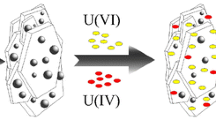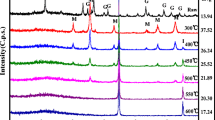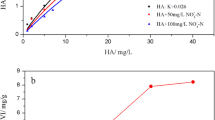Abstract
In this study, nanoscale zero-valent iron (NZVI) were immobilized within a chelating resin (DOW 3N). To investigate the effect of Fe loading on NZVI reactivity, three NZVI-resin composites with different Fe loading were obtained by preparing Fe(III) solution in 0, 30 and 70% (v/v) ethanol aqueous, respectively; the bromate was used as a model contaminant. TEM reveals that increasing the Fe loading resulted in much larger size and poor dispersion of nanoscale iron particles. The results indicated that the removal efficiency of bromate and the rate constant (K obs) were decreased with increasing the Fe loading. For the NZVI-resin composite with lower Fe loading, the removal efficiency of bromate declined more significantly with the increase of DO concentrations. Under acidic conditions, decreasing the pH value had the most significant influence on NZVIR3 with highest Fe loading for bromate removal; however, under alkaline conditions, the most significant influence of pH was on NZVI-R1 with lowest Fe loading. The effects of co-existing anions NO –3 , PO 3–4 and HCO –3 were also investigated. All of the co-existing anions showed the inhibition to bromate reduction.
Similar content being viewed by others
References
Liu Y, Lowry G V. Effect of particle age (Fe0 content) and solution pH on NZVI reactivity: H2 evolution and TCE dechlorination. Environmental Science & Technology, 2006, 40(19): 6085–6090
Liu Y, Majetich S A, Tilton R D, Sholl D S, Lowry G V. TCE dechlorination rates, pathways, and efficiency of nanoscale iron particles with different properties. Environmental Science & Technology, 2005, 39(5): 1338–1345
Shu H Y, Chang M C, Chen C C, Chen P E. Using resin supported nano zero-valent iron particles for decoloration of Acid Blue 113 azo dye solution. Journal of Hazardous Materials, 2010, 184(1–3): 499–505
Lowry G V, Johnson K M. Congener-specific dechlorination of dissolved PCBs by microscale and nanoscale zerovalent iron in a water/methanol solution. Environmental Science & Technology, 2004, 38(19): 5208–5216
Zhu S N, Liu G H, Ye Z, Zhao Q, Xu Y. Reduction of dinitrotoluene sulfonates in TNT red water using nanoscale zerovalent iron particles. Environmental Science and Pollution Research International, 2012, 19(6): 2372–2380
Zhang X, Lin S, Lu X Q, Chen Z L. Removal of Pb(II) from water using synthesized kaolin supported nanoscale zero-valent iron. Chemical Engineering Journal, 2010, 163(3): 243–248
Li X Q, Zhang W X. Iron nanoparticles: the core-shell structure and unique properties for Ni(II) sequestration. Langmuir, 2006, 22(10): 4638–4642
Uezuem C, Shahwan T, Eroglu A E, Hallam K R, Scott T B, Lieberwirth I. Synthesis and characterization of kaolinite-supported zero-valent iron nanoparticles and their application for the removal of aqueous Cu2+ and Co2+ ions. Applied Clay Science, 2009, 43(2): 172–181
Shi L N, Zhou Y, Chen Z, Megharaj M, Naidu R. Simultaneous adsorption and degradation of Zn2+ and Cu2+ from wastewaters using nanoscale zero-valent iron impregnated with clays. Environmental Science and Pollution Research International, 2013, 20(6): 3639–3648
Cao J S, Elliott D, Zhang W X. Perchlorate reduction by nanoscale iron particles. Journal of Nanoparticle Research, 2005, 7(4–5): 499–506
Xiong Z, Zhao D, Pan G. Rapid and complete destruction of perchlorate in water and ion-exchange brine using stabilized zerovalent iron nanoparticles. Water Research, 2007, 41(15): 3497–3505
Hwang Y H, Kim D G, Shin H S. Mechanism study of nitrate reduction by nano zero-valent iron. Journal of Hazardous Materials, 2011, 185(2–3): 1513–1521
Sohn K, Kang S W, Ahn S, Woo M, Yang S K. Fe0 nanoparticles for nitrate reduction: stability, reactivity, and transformation. Environmental Science & Technology, 2006, 40(17): 5514–5519
Westerhoff P. Reduction of nitrate, bromate, and chlorate by zero valent iron (Fe0). Journal of Environmental Engineering, 2003, 129(1): 10–16
Xie L, Shang C. The effects of operational parameters and common anions on the reactivity of zero-valent iron in bromate reduction. Chemosphere, 2007, 66(9): 1652–1659
Wu X, Yang Q, Xu D, Zhong Y, Luo K, Li X, Chen H, Zeng G. Simultaneous adsorption/reduction of bromate by nanoscale zerovalent iron supported on modified activated carbon. Industrial & Engineering Chemistry Research, 2013, 52(35): 12574–12581
Wang Q, Snyder S, Kim J, Choi H. Aqueous ethanol modified nanoscale zero-valent iron in bromate reduction: synthesis, characterization, and reactivity. Environmental Science & Technology, 2009, 43(9): 3292–3299
Alowitz M J, Scherer M M. Kinetics of nitrate, nitrite, and Cr(VI) reduction by iron metal. Environmental Science & Technology, 2002, 36(3): 299–306
Hwang Y H, Kim D G, Shin H S. Effects of synthesis conditions on the characteristics and reactivity of nano scale zero-valent iron. Applied Catalysis B: Environmental, 2011, 105(1–2): 144–150
He F, Zhao D. Manipulating the size and dispersibility of zerovalent iron nanoparticles by use of carboxymethyl cellulose stabilizers. Environmental Science & Technology, 2007, 41(17): 6216–6221
Zhu H, Jia Y, Wu X, Wang H. Removal of arsenic from water by supported nano zero-valent iron on activated carbon. Journal of Hazardous Materials, 2009, 172(2–3): 1591–1596
Choi H, Al-Abed S R. Effect of reaction environments on the reactivity of PCB (2-chlorobiphenyl) over activated carbon impregnated with palladized iron. Journal of Hazardous Materials, 2010, 179(1–3): 869–874
Zhang Y, Li Y, Li J, Hu L, Zheng X. Enhanced removal of nitrate by a novel composite: nanoscale zero-valent iron supported on pillared clay. Chemical Engineering Journal, 2011, 171(2): 526–531
Wang W, Zhou M H, Mao Q O, Yue J J, Wang X. Novel NaY zeolite-supported nanoscale zero-valent iron as an efficient heterogeneous Fenton catalyst. Catalysis Communications, 2010, 11(11): 937–941
Ponder S M, Darab J G, Bucher J, Caulder D, Craig I, Davis L, Edelstein N, Lukens W, Nitsche H, Rao L F, Shuh D K, Mallouk T E. Surface chemistry and electrochemistry of supported zerovalent iron nanoparticles in the remediation of aqueous metal contaminants. Chemistry of Materials, 2001, 13(2): 479–486
Jiang Z, Lv L, Zhang W, Du Q, Pan B, Yang L, Zhang Q. Nitrate reduction using nanosized zero-valent iron supported by polystyrene resins: role of surface functional groups. Water Research, 2011, 45(6): 2191–2198
Shi J, Yi S, He H, Long C, Li A. Preparation of nanoscale zerovalent iron supported on chelating resin with nitrogen donor atoms for simultaneous reduction of Pb2+ and NO–3. Chemical Engineering Journal, 2013, 230: 166–171
Moore M M, Chen T. Mutagenicity of bromate: implications for cancer risk assessment. Toxicology, 2006, 221(2–3): 190–196
Diniz C V, Ciminelli V S T, Doyle F M. The use of the chelating resin Dowex M-4195 in the adsorption of selected heavy metal ions from manganese solutions. Hydrometallurgy, 2005, 78(3–4): 147–155
Diniz C V, Doyle F M, Ciminelli V S T. Effect of pH on the adsorption of selected heavy metal ions from concentrated chloride solutions by the chelating resin Dowex M-4195. Separation Science and Technology, 2002, 37: 3169–3185
Wang W, Jin Z H, Li T L, Zhang H, Gao S. Preparation of spherical iron nanoclusters in ethanol-water solution for nitrate removal. Chemosphere, 2006, 65(8): 1396–1404
Jia H, Gu C, Boyd S A, Teppen B J, Johnston C T, Song C, Li H. Comparison of reactivity of nanoscaled zero-valent iron formed on clay surfaces. Soil Science Society of America Journal, 2011, 75(2): 357–364
Tan B J, Klabunde K J, Sherwood P M A. X-ray photoelectronspectroscopy studies of solvated metal atom dispersed catalysts. Monometallic iron and bimetallic iron cobal particles on alumina. Chemistry of Materials, 1990, 2(2): 186–191
Liou Y H, Lo S L, Kuan W H, Lin C J, Weng S C. Effect of precursor concentration on the characteristics of nanoscale zerovalent iron and its reactivity of nitrate. Water Research, 2006, 40(13): 2485–2492
Yin W, Wu J, Li P, Wang X, Zhu N, Wu P, Yang B. Experimental study of zero-valent iron induced nitrobenzene reduction in groundwater: the effects of pH, iron dosage, oxygen and common dissolved anions. Chemical Engineering Journal, 2012, 184: 198–204
Huang Y H, Zhang T C. Effects of dissolved oxygen on formation of corrosion products and concomitant oxygen and nitrate reduction in zero-valent iron systems with or without aqueous Fe2+. Water Research, 2005, 39(9): 1751–1760
Devlin J F, Allin K O. Major anion effects on the kinetics and reactivity of granular iron in glass-encased magnet batch reactor experiments. Environmental Science & Technology, 2005, 39(6): 1868–1874
Agrawal A, Ferguson W J, Gardner B O, Christ J A, Bandstra J Z, Tratnyek P G. Effects of carbonate species on the kinetics of dechlorination of 1,1,1-trichloroethane by zero-valent iron. Environmental Science & Technology, 2002, 36(20): 4326–4333
Reardon E J. Anaerobic corrosion of granular iron: measurement and interpretation of hydrogen evolution rates. Environmental Science & Technology, 1995, 29(12): 2936–2945
Kober R, Schlicker O, Ebert M, Dahmke A. Degradation of chlorinated ethylenes by Fe0: inhibition processes and mineral precipitation. Environmental Geology, 2002, 41: 644–652
Phillips D H, Gu B, Watson D B, Roh Y, Liang L, Lee S Y. Performance evaluation of a zero-valent iron reactive barrier: mineralogical characteristics. Environmental Science & Technology, 2000, 34(19): 4169–4176
Author information
Authors and Affiliations
Corresponding author
Electronic supplementary material
Rights and permissions
About this article
Cite this article
Shi, J., Yi, S., Long, C. et al. Effect of Fe loading quantity on reduction reactivity of nano zero-valent iron supported on chelating resin. Front. Environ. Sci. Eng. 9, 840–849 (2015). https://doi.org/10.1007/s11783-015-0781-2
Received:
Accepted:
Published:
Issue Date:
DOI: https://doi.org/10.1007/s11783-015-0781-2




